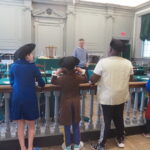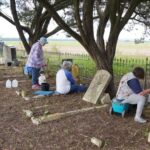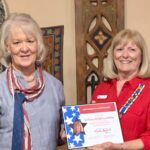American period rooms are a phenomenon of the Colonial Revival period. Just as the National Society Daughters of the American Revolution (NSDAR) was at the forefront of the Colonial Revival, the DAR Museum period rooms are among the earliest in America. Texas is honored to sponsor one of the period rooms in the DAR Museum.
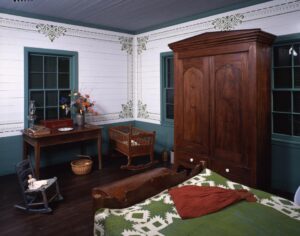 The Texas Room suggests a bedroom decorated in the German immigrant style of a mid-to-late 19th-century bedroom. The inspiration for its decoration came from a bedroom in a mid-19th-century extant house originally located in Alleyton, Texas. The decorative motifs and furnishings are evocative of Germanic contributions to the American decorative arts.
The Texas Room suggests a bedroom decorated in the German immigrant style of a mid-to-late 19th-century bedroom. The inspiration for its decoration came from a bedroom in a mid-19th-century extant house originally located in Alleyton, Texas. The decorative motifs and furnishings are evocative of Germanic contributions to the American decorative arts.
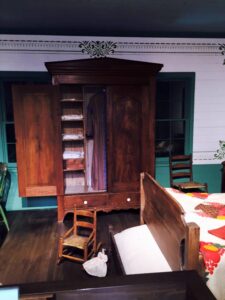 The Texas Room bedroom is filled with furniture made in Texas, which reflects the skill of German cabinetmakers. The large pine wardrobe, or kleiderschrank, ca. 1860-1870, dominates the room. The double paneled doors open to reveal beautiful textiles, donated by Texas Daughters, and pieces from the DAR Museum’s core collection that are on display. The double paneled doors are carved with Gothic detail and the wardrobe is topped by a graceful cornice and pediment. The wardrobe drawers provided much-needed storage and security for the early settlers. A previously undiscovered “valuables” hidden space behind one of the drawers was discovered in October 2003 by Curator Patrick Sheary and Texas Room Chairman, Sandy Bassett, during space remodeling efforts.
The Texas Room bedroom is filled with furniture made in Texas, which reflects the skill of German cabinetmakers. The large pine wardrobe, or kleiderschrank, ca. 1860-1870, dominates the room. The double paneled doors open to reveal beautiful textiles, donated by Texas Daughters, and pieces from the DAR Museum’s core collection that are on display. The double paneled doors are carved with Gothic detail and the wardrobe is topped by a graceful cornice and pediment. The wardrobe drawers provided much-needed storage and security for the early settlers. A previously undiscovered “valuables” hidden space behind one of the drawers was discovered in October 2003 by Curator Patrick Sheary and Texas Room Chairman, Sandy Bassett, during space remodeling efforts.
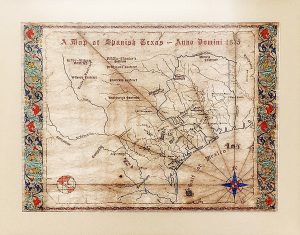 Hanging just outside the entrance to the Texas Room is a “Map of Spanish Texas,” which was given to the DAR Museum by the Texas State Society in 1975. It is a ca. 1930-1950 copy of an 1835 map of Texas. In 2004 the Texas State Society funded the conservation efforts of this wonderful piece and the map was repaired, rematted, and reframed.
Hanging just outside the entrance to the Texas Room is a “Map of Spanish Texas,” which was given to the DAR Museum by the Texas State Society in 1975. It is a ca. 1930-1950 copy of an 1835 map of Texas. In 2004 the Texas State Society funded the conservation efforts of this wonderful piece and the map was repaired, rematted, and reframed.
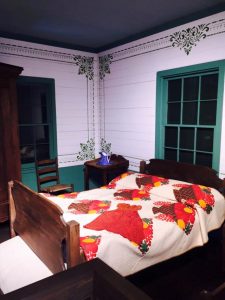 The walls of the room were hand-stenciled with designs found in the farmhouse mentioned above. The wood construction and the window detail were also copied from the original house. A pine cradle closely resembles those made in 17th century Germany or in earlier German-American settlements. The curved design of the headboard and footboard is repeated in rocking chairs not shown. It dates from c.1870 and is from Bernardo, Colorado County, Texas.
The walls of the room were hand-stenciled with designs found in the farmhouse mentioned above. The wood construction and the window detail were also copied from the original house. A pine cradle closely resembles those made in 17th century Germany or in earlier German-American settlements. The curved design of the headboard and footboard is repeated in rocking chairs not shown. It dates from c.1870 and is from Bernardo, Colorado County, Texas.
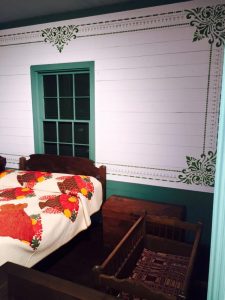 The pegged walnut table has a molded apron, tapered legs, and a drawer. It dates from c.1865. The child’s wooden-slat back rocking chair is painted blue over brown and has a rawhide seat laced to the frame with rawhide strips. It dates from the late 19th century.
The pegged walnut table has a molded apron, tapered legs, and a drawer. It dates from c.1865. The child’s wooden-slat back rocking chair is painted blue over brown and has a rawhide seat laced to the frame with rawhide strips. It dates from the late 19th century.
New additions to the Texas Room in 2004 include a dressing table mirror, American, c. 1840 –1850. The dressing table was made of mahogany and mahogany veneers with white pine as the secondary wood.
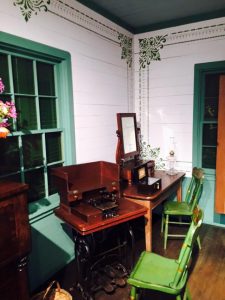 Another addition to the Texas Room in 2004 is a chest of drawers which was conserved by Texas Daughters to honor State Regent Donna Raymond. The chest is made of mahogany, maple, poplar and white pine and has carved feet and figured veneers. The chest is a Neoclassical style and was made in New York City, ca. 1835.
Another addition to the Texas Room in 2004 is a chest of drawers which was conserved by Texas Daughters to honor State Regent Donna Raymond. The chest is made of mahogany, maple, poplar and white pine and has carved feet and figured veneers. The chest is a Neoclassical style and was made in New York City, ca. 1835.
Currently visiting the Texas State Room from the core NSDAR Museum Collection are a rare ca. 1860 Wilcox & Co. sewing machine and two beautifully painted chairs from the mid 19th century.
Many beautiful furnishings donated by Texas Daughters that formerly resided in the Texas Room are now being displayed in other State Rooms. One such item is a beautiful piano which is now on display in the Kentucky State Room.
Upon your next visit to Washington, D.C., stop by and visit the Texas State Room and all the wonderful new additions, as well as the Kentucky Room with the magnificent piano! Questions can be directed to our Texas Room Chair.


